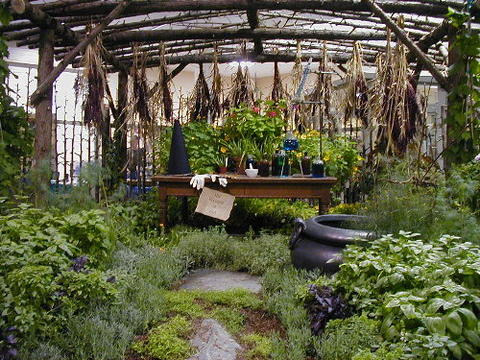
For many Wiccans, growing herbs is more than just a rewarding hobby; it is a religious experience. Working in a garden is a powerful way for Wiccans to attune with the earth and honor Goddess and God. Wiccans use many herbs for sacred rituals and workings, and it is nice to know exactly where your herbs came from and under what conditions they were grown when using them for spiritual purposes. In addition, when growing your own herbs, you can lend them a bit of extra energy to help give a boost to your workings.
Step 1
Decide which herbs you want to grow. Healers might grow aloe for salves, coneflower (echinacea) for tonics, or comfrey for poultices. "Kitchen Witches," Wiccans who prefer more domestic-style magic done in the kitchen rather than elaborate rituals, might prefer mugwort for divination teas, basil for love potions, or licorice to add to sauces to bring peace to a troubled home. According to Scott Cunningham, author of Cunningham's Encyclopedia of Magical Herbs, some traditional powerful protection herbs are belladonna, foxglove and wolfsbane, but be cautious, as these plants are highly toxic. If you have limited space, choose a few of the most versatile herbs safe for ritual, culinary and medicinal uses: bay, catnip, chamomile, fennel, lavender, mint, mullein, pot marigold, rose rosemary, sage and thyme.
Step 2
Plan your gardening schedule by astrological moon phases for success. Wiccan herbs can gain a boost from planetary influences, according to Gene McAvoy, horticulture agent with the Hendry County Extension Service of the University of Florida Cooperative Extension. Herbs sown or transplanted when the moon is in Cancer or Scorpio will germinate quickly and produce profusely. Gemini is a barren sign which is bad for plant production, so it is a perfect time for weeding the garden. Look for books on astrological gardening, or see resources below.
Step 3
Use crystals to lend energy to your magical herbs. If your garden plot is square or rectangular, bury 5 quartzcrystals in it: one in each corner, and one in the center. If your herb garden is circular, imagine a sacred pentagram laying over the circle and bury the quartz at what would be the five points. Place a carnelian at the base of each plant to encourage growth. Mix small pieces of amethyst in with soil whenever you are preparing a new bed to help cleanse the plot. When transplanting, place a hematite into the hole or at the bottom of a pot to encourage strong and deep rooting. Be sure to cleanse, consecrate and charge your crystals in your traditional ritual manner before using them in your garden.
Step 4
Water your Wiccan herbs with blessed water. You can create blessed water by collecting rain water then cleansing, consecrating and charging it as you would in your traditional ritual manner. You can add a few drops of vetivert or patchouli essential oil to promote fertility and prosperity. Place an amethyst in it to keep it cleansed and energized, and keep it in a jar or container with a lid. Fill your watering can with regular water, and add a splash of blessed water. At each new moon and full moon, water each of your herbs with the blessed water. Even if you have another watering system, add just a splash of the blessed water.
Step 5
Harvest herbs with a consecrated knife. Many Wiccans keep a boline (curved, usually white-handled, knife), a Wiccan ritual tool used exclusively for spiritual workings.


No comments:
Post a Comment